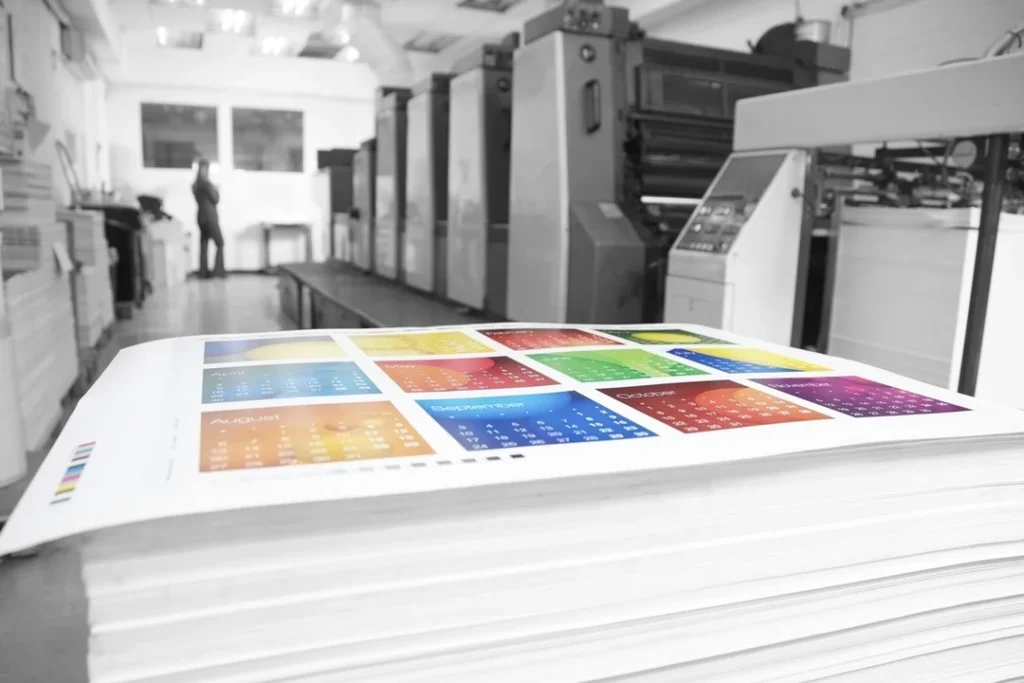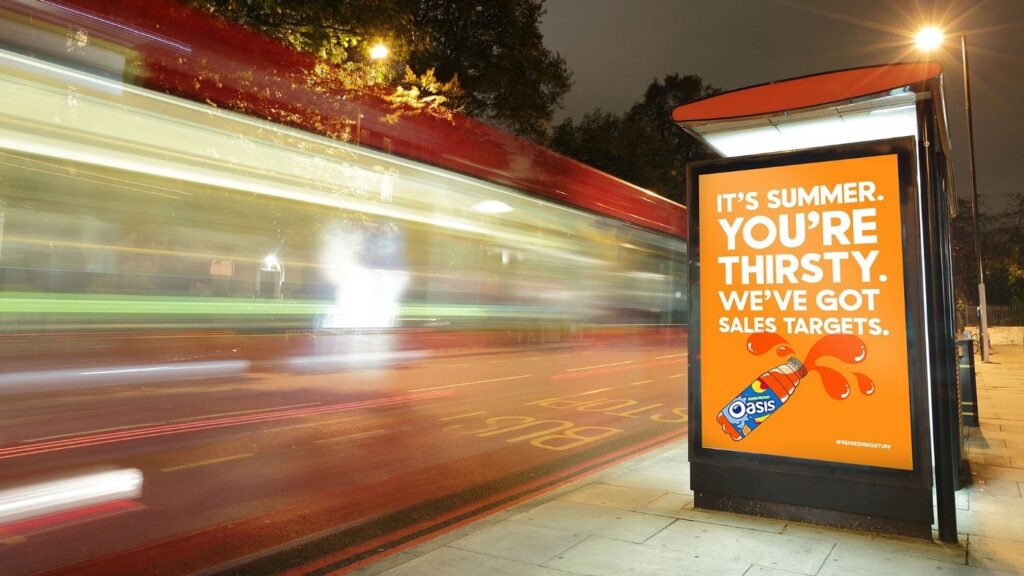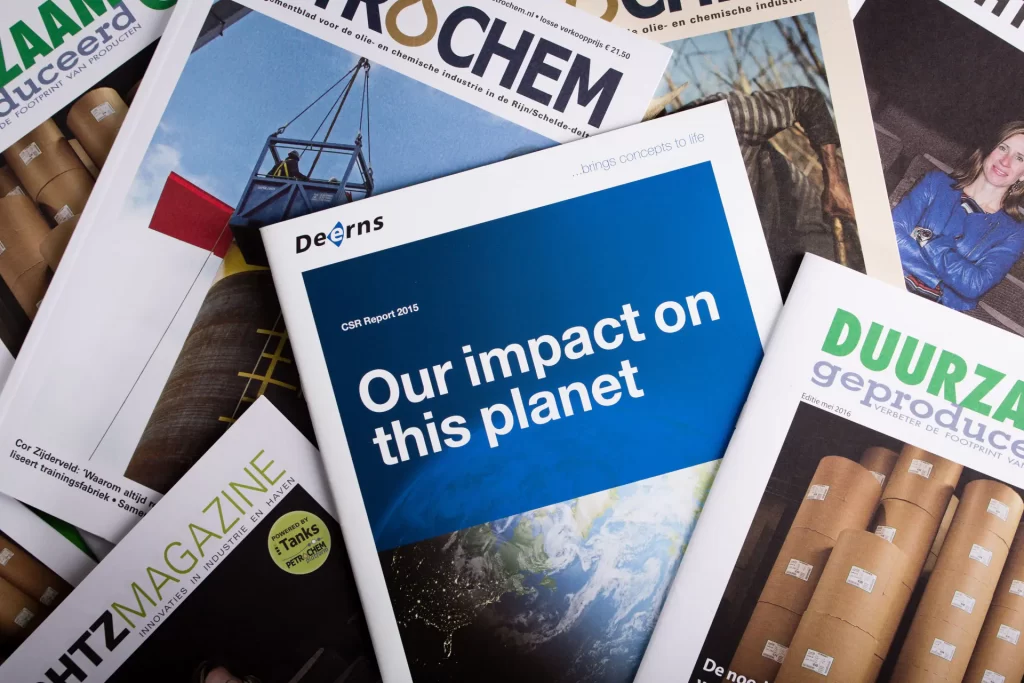Print Strategy in Marketing: How to Leverage Physical Media
We’re in a digital world, no doubt about that. With the internet and social media taking over our lives, you might think that print is dead. But, my friends, you’d be mistaken.
While the future of marketing lies in shiny new technology, nothing beats a well-designed printed ad or brochure. And this retro medium has a better chance of standing out in today’s age of information overload—like that excellent vinyl record you found in your parent’s attic or the newspaper on your doorstep every Sunday morning.
So, let’s dive into print strategy and see how it can help boost your marketing game. Are you ready to get creative with ink? Let’s go!
Table of Contents
Does Print Marketing Still Matter?

“But Tom,” I hear you say, “Print is sooooo old school. Why should I invest in something stuck in the past?”
Well, Mr. or Ms. Sceptic, here are three reasons why print marketing still matters:
- Physical Presence: You can’t hold an email or a banner ad on your computer screen (unless you’re Thor). Print ads and mailers have a physical presence that grabs attention much faster than anything digital can do. Remember receiving a handwritten letter from a friend instead of an email? It just hits differently.
- Lasting Impression: Digital content is often skimmed and forgotten almost instantly after we click away from it (especially when no cat is involved). Printed materials stick around for longer — whether intended to be saved by consumers or simply discovered under piles of useless stuff years later.
- Credibility Boost: There’s something about print that screams professionalism and credibility. No one knows precisely what it is—are people just impressed by paper?—but consumers tend to view print as more trustworthy than digital marketing (which could be one reason why online news isn’t taken seriously any more).
Developing an Effective Print Strategy
So you're a believer in print, aren't you? Well, I can't say I blame you. There's just something so tantalising about the written word on paper. But here’s the big question: how do you create a print strategy that works? Fear not, my friend, because I’m here to guide you through it with the wisdom of a marketing sage (okay, maybe more like an enthusiastic student).
Goal and Audience
Before you start sketching up designs or pulling out your wallet for print runs, there’s one thing you absolutely must do first. You need to zoom out and look at the big picture of what this project is all about. What are your goals? Who is your target audience?
Doing a deep dive into these two questions will shape everything that comes after — from design decisions to where and how you distribute. It may seem tedious and unnecessary now, but it’ll make things smoother.
Choose Your Formats
The print world is vast and varied, with formats ranging from brochures to postcards to newspapers. Trying to navigate it can leave your head spinning! But don’t worry yourself too much because every format has its strengths.
For example, if you run a local business and want people to walk through your door, simple flyers could be all you need! They’re cost-effective, easy to get into hands, and can give readers the jolt they require if done right.
On the other hand, if you’re redesigning your company’s brand or launching a new product line, glossy catalogues or magazine spreads might be what tickles your fancy.
Just remember — think about what fits within your goals, budget, and target audience.
Design for Impact
Something everyone should know whether they're in marketing or not — design is EVERYTHING! It's no secret that when someone sees one of your print pieces, they look at a physical representation of your brand. So, they have to look good.
But great design isn’t just about appearances. It’s about guiding the reader's eye in a way that helps them understand what you’re all about and what you want from them. You know what they say — “A picture is worth a thousand words”, and every element should tell your brand's story in a way that hits home with your target audience.
Do you not feel too confident in your design skills? No problem! That’s precisely why designers exist (whether an agency or freelancer). But if you’re brave enough to give it a whirl yourself, try Canva or Adobe Express for some intuitive DIY tools.
Remember: You only get one shot at making a first impression, so make it count!
Print Distribution Strategies

You've done the hard work. You’ve set your goals, chosen your formats, and designed print pieces that make Michelangelo look like he was just finger painting. So now what? How do you get them into the hands of your target audience?
Look no further; I have a treasure trove of distribution strategies to share! Some are classic, some new, but all are effective in their own right for every marketing wizard out there.
Direct Mail
The OG of print distribution. Sure, it may seem a bit old school in today’s digital age, but this bad boy can still pack a wallop when appropriately executed.
Just think about it: what’s better than receiving nicely packaged mail specifically sent to you? Not much! Successful direct mail campaigns tend to have highly targeted mailing lists and offers or messaging that compel people to act. Personalisation also helps since consumers are far more likely to engage with materials they feel were intended for them specifically.
One thing to take note of, though, is cost. Direct mail can get pricey, especially if you’re working with large mailing lists or incorporating bells and whistles such as dimensional mailers or freebies. Crunch the numbers first and set a realistic budget before diving head first.
In-Person Distribution
Sometimes, all we need is some good old-fashioned human interaction… well, at least regarding marketing. There's just something powerful about putting printed materials directly into the hands (or pockets) of someone interested in your brand.
You can achieve this tactic in countless ways, such as handing out flyers at local events or leaving brochures in high-traffic areas. However, each method starts with identifying valuable locations where your target audience spends time, so research beforehand.
Alternate Distribution Channels
While traditional tactics like direct mail and in-person distribution still work like a charm, there are plenty of modern alternatives to consider. Here are a few ideas that you may find helpful:
- Ride-sharing services: Partner with companies like Uber or Lyft to have your branded materials put in their cars or even have them implement an in-app ad.
- Subscription boxes: Who doesn’t love a good subscription box? If your target audience is into them, consider including product samples, catalogues, or branded inserts for maximum reach potential.
- Targeted media buys: Find local newspapers and niche magazines that align with your target audience—and secure ad placements within them.
- Influencer collaborations: Team up with influential creators in your industry to distribute branded print pieces to their engaged followers.
The key is to think outside normality and try out channels that make sense for your specific brand and marketing objectives. Get creative!
Integrating Print with Digital Channels

Print has a charm, but the best marketers know that using print and digital channels is the key to perfect marketing. Combining the power of print with the reach and data-driven capabilities of digital lets you make experiences for your customers at every point of contact.
So, how do you start weaving them together? Here are some strategies:
QR Codes and Dynamic Print
Before, QR codes were often seen as gimmicks and ineffective. Thanks to the pandemic, we've learned they're pretty handy! With these barcodes, you can connect customers to more content, exclusive offers, product videos and more with a phone scan. But why stop there? AR experiences in your print or even personalised printing pieces are great ways to keep your audience interested.
Integrated Campaigns
True synergy happens when integrated campaigns are made. This means all your materials have to work together. For example, launching a new product line with print catalogues, including eye-catching digital ads, social media teasers, and an immersive microsite. In each element, something should keep your brand top-of-mind throughout their journey.
Data-Driven Optimisation
Data is king on the web — but did you know print can also work off data? By using variable data printing (VDP) and campaign tracking tools, you can create personal experiences for each customer that make them feel like they’re being spoken to directly. For example, using customer data to populate catalogues or direct mail pieces with recommendations-tailored messaging will add that personal touch customers love.
In conclusion, use this mix of emotion from print into performance-driven strategies so customers know not only you care about them but about optimising their experience, too.
Measuring the Success of Your Print Strategy
“But Tom,” I’m sure you’re saying, “how do I know if all this print marketing stuff is working?”
Great question, curious reader! As with any marketing effort, you’ll need a measurement and reporting strategy to monitor how well your prints perform. After all, something isn’t worth improving if you don’t know the numbers that prove it right.
Here are some key metrics and steps for checking whether your print strategy works:
- Campaign tracking: Use unique codes, QR codes or dedicated URLs to document engagement and see who’s responding to what.
- Sales data: If your prints promote products or offers, then note what’s being sold so that you can notice any revenue impact.
- Brand awareness and perception: Run surveys or focus groups to determine how much exposure people had to your brand after significant print pushes. You can also find out about favorability before and after these campaigns.
- Cost analysis: Pay close attention to everything that goes into printing (designing, distribution, etc.) alongside certain returns to calculate ROI.
The key here is putting upfront effort into KPIs and measuring strategies. That way, as time passes on different campaigns, you’ll be able to analyse things quickly enough to make the best adjustments possible for maximum impact in the long run.
The Future of Print Marketing

We’ve established that print is far from dead. It’s alive and kicking, more vibrant than ever. However, the future of print advertising will eventually have to change because technology keeps evolving at record speed.
What does that future look like? Get ready for these tantalising possibilities:
- More personalised and customised: With new data analytics, variable data printing, and on-demand production technologies, your piece can be tailored even more to match the preferences and behaviours of each customer.
- Experiential and interactive: There might come a time when printed materials aren’t just flat pieces of paper any more. Imagine augmented reality experiences or printable electronics that blur the physical and digital lines.
- Sustainable and eco-friendly: People are becoming more environmentally conscious as time goes on. Expect a surge in sustainable practices such as using recycled materials or energy-efficient production methods.
- Print-on-demand and localised production: Not only do substantial centralised print runs create waste, but they also don’t enable agile-targeted campaigns. The future may demand less waste through localised on-demand printing solutions.
- Continued convergence with digital: Digital isn’t going anywhere soon, but there will be tighter integration to get the best of both worlds. These seamless experiences will hopefully leverage the strengths of both channels.
While it’s impossible to know what exactly will happen decades later… One thing is obvious: Print marketing will continue evolving alongside technology to stay relevant for years. So hop on board now! You’ll be ahead of the curve by embracing this powerful tool early. Customers always appreciate it when you’re innovative!
FAQs
In the age of digital marketing, why is print media still relevant?
With a great deal of discourse indicating its near-extinction, it's important to note that print media continues to be an effective way of reaching consumers in a tangible and long-lasting manner. Digital materials can easily get lost in the shuffle and be quickly forgotten, while physical ones leave a lasting impression and complement digital campaigns exceptionally well.
What are some benefits of incorporating print media into your marketing strategy?
The benefits include increased credibility and perceived value, better engagement, increased recall targetability through strategic distribution, and creating a multisensory experience with resonance for customers.
Which types of print materials are best for marketing?
When considering which types of print materials you should use for effectively marketing your product or service, consider brochures, catalogues, direct mail pieces, flyers, postcards, magazines, newspapers, billboards, and signage. The specific choice depends on your target audience's budgeting and overall objectives.
How do you integrate Print Materials with Digital Marketing efforts?
By linking them together! Implement URLs, QR codes or even augmented reality elements that link to online content. Promote social media channels or hashtags on your printed material to ensure customers can find you offline if they choose to explore further branding, and messaging should always be consistent across all channels.
How can you design the most effective prints?
Other points should be considered, such as using high-quality visuals and imagery incorporating white space for uncluttered design. Adhering to brand guidelines for consistency, using clear call-to-action buttons, and following up with your customer base frequently will ensure that your designs excel.
How do you distribute prints effectively?
Whether passing out flyers or sending direct mail, effective strategies include utilising mailing lists or geographic data, spreading advertisements in high-traffic areas, distributing prints at events or conferences and partnering with relevant publications or businesses for co-marketing opportunities.
How do I know if my print marketing campaigns are successful or not?
You’ll need to measure your success through various metrics to know for sure. Data such as response rates, coupon redemptions, website visits, lead generation sales and brand awareness surveys will accurately depict how well you did.
What are some tips on maximising the impact of print material?
A few tips include utilising eye-catching finishes or special printing techniques, like embossing or foil stamping, incorporating interactive and personalised elements into your designs, offering incentives with promotions and consistently reinforcing across channels.
How do you address sustainability in a print media strategy?
Use recyclable methods! You can use eco-friendly printing methods and materials, reduce waste by strategically targeting and distributing prints and promote digital alternatives where possible.
What’s the biggest challenge that comes with using print media for marketing?
The biggest challenge here is higher costs compared to digital marketing. On top of that, it takes longer to produce materials, and it's challenging to measure ROI. Most importantly, it runs the risk of becoming outdated quickly. However, although these challenges seem daunting initially, they can promptly be addressed through careful budgeting, integration with other online platforms, and frequent updates.
